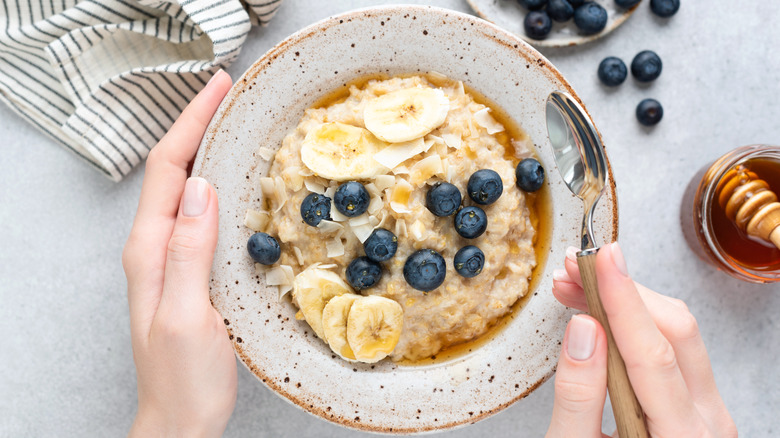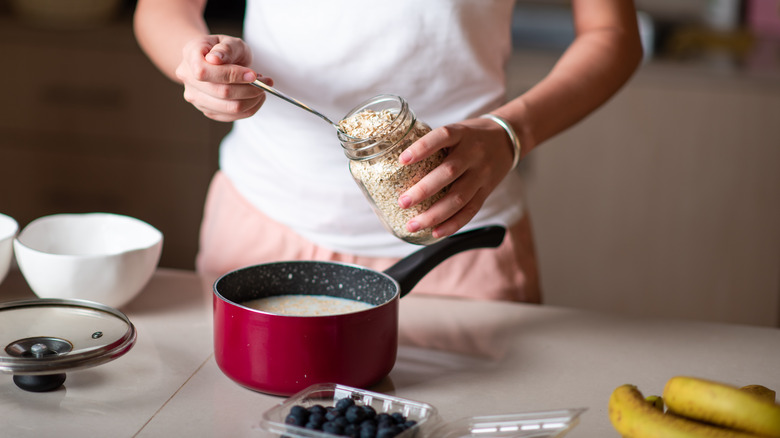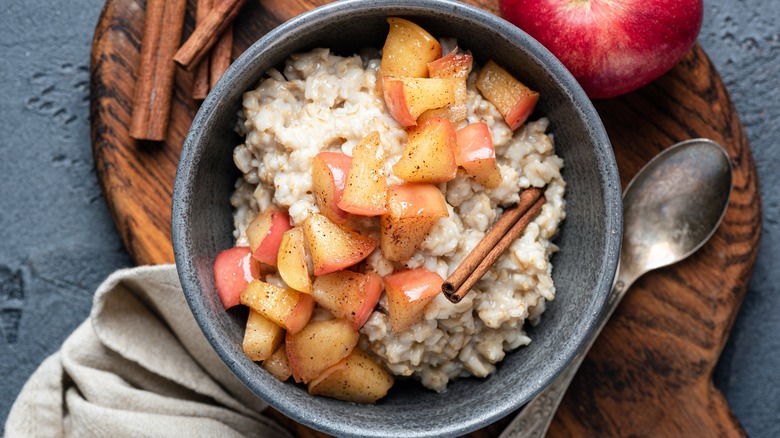Pay Attention To Your Liquid Ratio For A Better Bowl Of Oatmeal
Despite its many health benefits, which include lower cholesterol and blood sugar levels as well as reduced blood pressure thanks to the many antioxidants present in it, oatmeal does not enjoy the same sort of popularity as all-time breakfast favorites like pancakes, French toast, or even yogurt and smoothie bowls. The culprit? Its taste and texture sometimes leave much to be desired.
While oatmeal's taste can be easily doctored with tasty syrups and toppings, the same cannot be said for its texture. The problem, though, isn't the oatmeal itself but rather how you cook it, and more specifically the amount of liquid that you use. It is generally believed that oats require twice the amount of liquid to cook properly, and while that is true for some, it isn't always the case: The liquid-to-oat ratio depends on the type of oats that you're using (and how thick you like your oatmeal).
For example, steel-cut oats take longer to cook and so require three or four times as much liquid. The same goes for whole oat groats — they need as much as four times the amount of liquid. Use too little, and your oats may end up dry and clumpy with an uncooked chew, making it a painful task to get through the bowl. But use too much, and you'll have an unappetizing bowl of watery and soupy mush that holds none of those delicious oatmeal toppings. We're aiming for porridge, not soup after all.
The best liquid for your oatmeal
The liquid-to-oat ratio remains the same no matter which liquid you choose, so it's a good idea to also consider what it is that you cook your oatmeal in. Water and milk remain the go-to liquids of choice, but each has its pros and cons. Preparing oatmeal with milk has many benefits: Milk will give your breakfast a protein boost that water cannot, and you also get all the benefits from the vitamins and minerals (such as calcium) present in it. Milk also adds a creamy richness to oatmeal — a flavor that water alone can't replicate.
That said, you might find that your oatmeal comes out a touch too thick and gloopy when you use milk, no matter how much you mind your liquid-to-oat ratio. Milk does tend to make the texture of oatmeal more sticky and slimy than water, which is where the latter undoubtedly comes out on top concerning consistency.
It's nothing to worry about though because you can always get the best of both worlds — aka the chewy but not too-chewy texture of perfectly cooked oats but with the added creaminess and protein-rich benefits of milk. To do so, prepare the oatmeal in water and then whisk in a bit of milk after it is done cooking. It's a win-win, really.
More tips to get your oatmeal right each time
The choice of liquid and its ratio aside, there could be other factors stopping your oatmeal from coming together in all its nutty glory. Oatmeal may seem like a dump-and-go meal where you throw everything into a pot at the same time and call it a day, but that could be the very thing ruining your nutritious breakfast bowl, depending on how you like its texture to be. This is because the temperature at which oats are added to your liquid matters more than you think. Bring the water to a boil, and only then add the oats, and you'll get a less gloopy result. Just make sure you drop the pot to a simmer after you add the oats.
Another thing that could make or break your oatmeal is the matter of stirring. Though stirring may seem like one way to prevent oats from burning (burned bits of oatmeal are notorious for being stubborn and nasty things to get off) or clumping, it could end up doing more harm. Stirring oats will release a lot of starch, which in turn could make your oatmeal sticky and gooey. To prevent it from turning into a slimy goop, let your oatmeal do its thing over medium to low heat. While whisking it every so often won't do much harm, you most certainly don't want to be stirring it the whole time!



